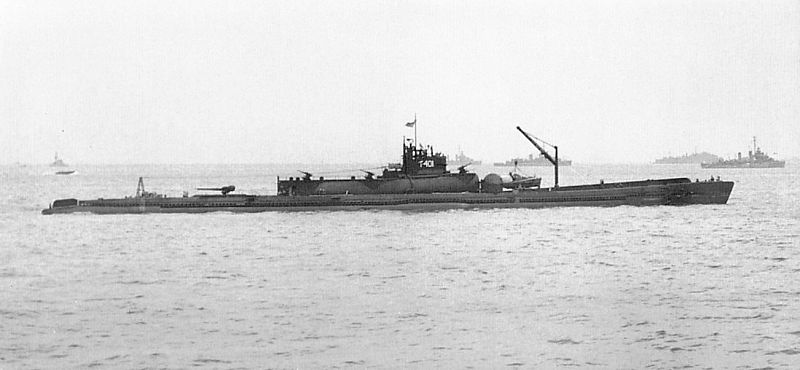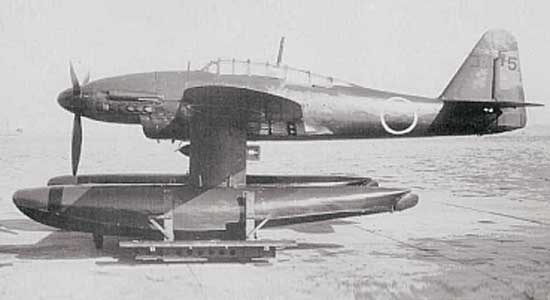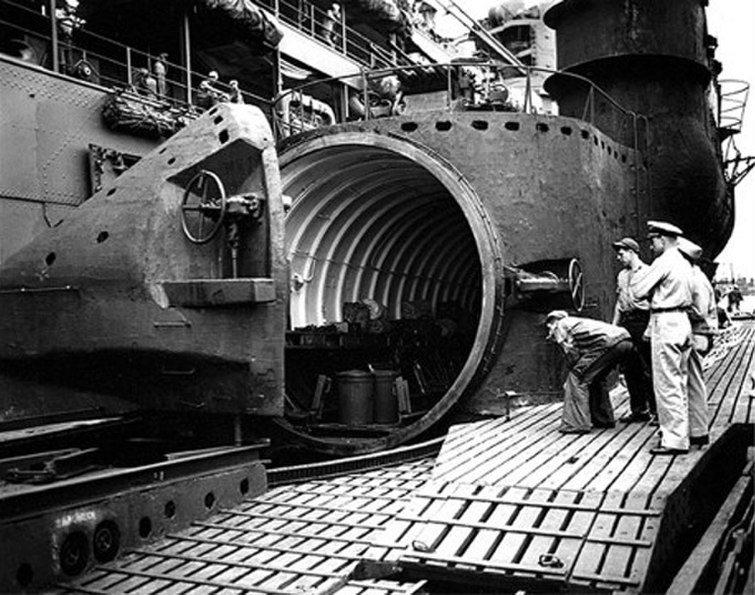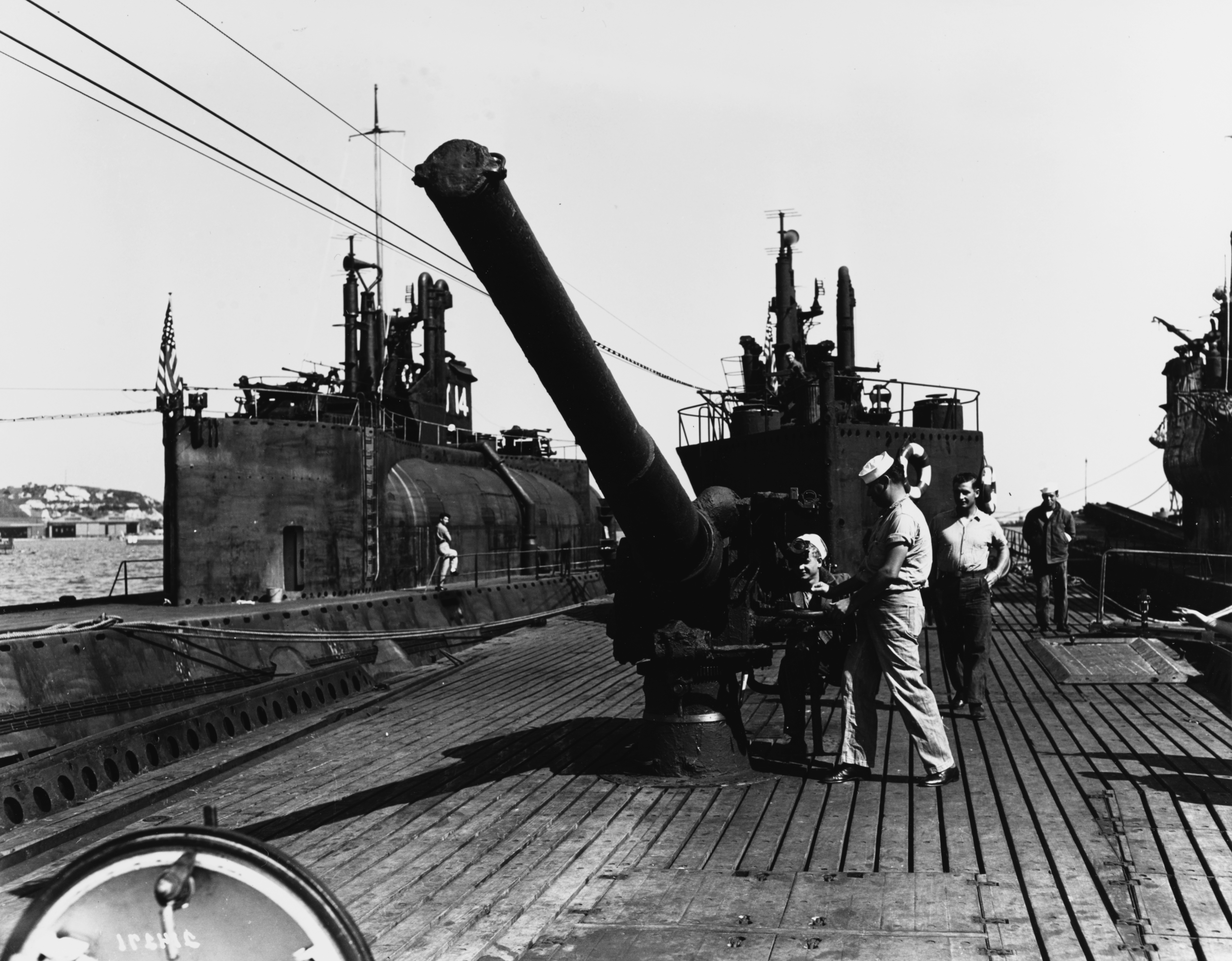Post 2.636
I-400 class submarine
| Class overview | |
|---|---|
| Operators: | |
| Cost: | 28,861,000 JPY in 1942 |
| Built: | January 18, 1943 to July 24, 1945 |
| In commission: | 1944–45 |
| Planned: | 18 |
| Completed: | 3 |
| Cancelled: | 15 |
| Active: | 0 |
| Lost: | 3 |
| Retired: | 0 |
| Preserved: | 0 |
| General characteristics | |
| Displacement: | 6,560 long tons (6,670 t) |
| Length: | 122 m (400 ft) |
| Beam: | 12.0 m (39.4 ft) |
| Draft: | 7.0 m (23.0 ft) |
| Propulsion: | 4 diesels: 1,680 kW (2,250 hp) each, surface 2 electric motors: 1,600 kW (2,100 hp) each, submerged |
| Speed: | 18.7 kn (34.6 km/h), surfaced 12 kn (22 km/h), submerged |
| Test depth: | 100 m (330 ft) |
| Complement: | 144 officers and men |
| Armament: | • 3 Aichi M6A1 Seiran sea-planes • 8 × 533 mm forward torpedo tubes • 1 × 140 mm (5.51 in) 40 caliber gun • 3 × 25 mm 3-barrel machine gun • 1 × 25 mm machine gun |
The Sen Toku I-400-class (伊四〇〇型潜水艦, I-yonhyaku-gata Sensuikan?) Imperial Japanese Navy submarines were the largest submarines of World War II and remained the largest ever built until the construction of nuclear ballistic missile submarines in the 1960s. They were submarine aircraft carriers able to carry three Aichi M6A Seiran aircraft underwater to their destinations. They were designed to surface, launch the planes then dive again quickly before they were discovered. They also carried torpedoes for close-range combat.

http://allaircraftsimulations.com/forum/viewtopic.php?f=43&t=23795
The I-400-class was designed with the range to travel anywhere in the world and return. A fleet of 18 boats was planned in 1942, and work started on the first in January 1943 at the Kure, Hiroshima arsenal. Within a year the plan was scaled back to five, of which only three (I-400 at Kure, and I-401 and I-402 at Sasebo) were completed.
Origins
The I-400 class submarine was the brainchild of Admiral Isoroku Yamamoto, Commander-in-Chief of the Japanese Combined Fleet. Shortly after the attack on Pearl Harbor in December 1941, he conceived the idea of taking the war to the United States mainland by making aerial attacks against cities along the US western and eastern seaboards using submarine-launched naval aircraft. He commissioned Captain Kameto Kuroshima to make a feasibility study.

I-400 beside submarine tender USS Proteus after the war. Note the large hangar and forward catapult. (US Navy photo, scanned from Polmar and Carpenter’s “Submarines of the Imperial Japanese Navy”) : http://combinedfleet.com/ships/i-400
Yamamoto submitted the resulting proposal to Fleet Headquarters on 13 January 1942. It called for a fleet of 18 large submarines capable of making three round-trips to the west coast of the United States without refueling or one round-trip to any point on the globe. They also had to be able to store and launch at least two attack aircraft armed with one torpedo or 800 kg (1,800 lb) bomb. By 17 March general design plans for the submarines were finalized. Construction of I-400 commenced at Kure Dock Yards on 18 January 1943, and four more boats followed: I-401 (April 1943) and I-402 (Oct 1943) at Sasebo; I-403 (Sept 1943) at Kobe and I-404 (February 1944) at Kure. Only three were completed.
Following Yamamoto’s death during an inspection tour of the Solomon Islands in April 1943, the number of aircraft-carrying submarines to be built was reduced from eighteen to nine, then five and finally three. Only I-400 and I-401 actually entered service; I-402 was completed on 24 July 1945, three weeks before the end of the war, but never made it to sea.
Characteristics
Each submarine had four 1,680 kW (2,250 hp) engines and carried enough fuel to go around the world one-and-a-half times—more than enough to reach the United States travelling east or west. Measuring more than 120 m (390 ft) long overall, they displaced 5,900 t (6,500 short tons), more than double their typical American contemporaries. The cross-section of its pressure hull had a unique figure-of-eight shape which afforded the necessary strength and stability to handle the weight of a large on-deck aircraft hangar. To allow stowage of three aircraft along the vessel’s centreline, the conning tower was offset to port.
Located approximately amidships on the top deck was a cylindrical watertight aircraft hangar, 31 m (102 ft) long and 3.5 m (11 ft) in diameter. The outer access door could be opened hydraulically from within or manually from the outside by turning a large hand-wheel connected to a rack and spur gear. The door was made waterproof with a 51-millimetre-thick (2.0 in) rubber gasket.
Sited atop the hangar were three water-proofed Type 96 triple-mount 25 mm (1.0 in) autocannon for AA defence, two abaft and one forward the conning tower. A single 25 mm (1.0 in) autocannon on a pedestal mount was also located just abaft the bridge. One Type 11, 140 mm (5.5 in) deck gun was positioned aft of the hangar. It had a range of 15,000 m (49,000 ft).
Eight torpedo tubes were mounted in the bow, four above and four below. There were no aft tubes.
Stowed in an open recessed compartment on the forward port side, just below top deck, was a collapsible crane used to retrieve the submarine’s Seiran floatplanes. The crane had an electrically operated hoist and was capable of lifting approximately 4.5 t (5.0 short tons). It was raised mechanically to a height of 8 m (26 ft) via a motor inside the boat. The boom extended out to a length of 11.8 m (39 ft).
A special trim system was fitted to the boats, allowing them to loiter submerged and stationary while awaiting the return of their aircraft. However, operation of this system was noisy and its usefulness was in doubt.
Strung along the submarine’s gunwales were two parallel sets of demagnetization cables, running from the stern to the bow planes. These were intended to dissipate the static charge that normally builds up when a boat’s hull slices through the water, causing the steel in the hull to deteriorate over time.
: http://modelshipmaster.com/products/submarines/i-400.htm
Electronics on board the I-400s included a Mark 3 Model 1 air search radar equipped with two separate antennas. This unit was capable of detecting aircraft out to a range of 80 km (43 nmi). The boats were also equipped with Mark 2 Model 2 air/surface radar sets with distinctive horn-shaped antennas. Each boat carried an E27 radar warning receiver, connected to both a trainable dipole antenna and a fixed non-directional antenna made up of a wire mesh basket and two metal rods.
The submarines were equipped with two periscopes of German manufacture, about 12.2 m (40 ft) long, one for use during daylight and the other at night.
A special anechoic coating made from a mixture of gum, asbestos, and adhesives, based on German technology, was applied to the hulls from the waterline to the bilge keel. This was intended to absorb or diffuse enemy sonar pulses and dampen reverberations from the boat’s internal machinery, making detection while submerged more difficult.
In May 1945, I-401 was fitted with a German-supplied snorkel, a hydraulically-raised air intake device allowing the boat to run its diesel engines and recharge its batteries while remaining at periscope depth. This retrofit occurred while the boat was laid up at Kure for repairs after being damaged by an American mine in April.
I-402 was completed immediately before the war ended, but had been converted during building to a tanker and was never equipped with aircraft.
The aircraft
The Aichi M6A Seiran
The hangar of the I-400s was originally designed to hold two aircraft. In 1943, however, Commander Yasuo Fujimori, Submarine Staff Officer of the Naval General Staff, requested it be enlarged. This was deemed feasible and, as remodelled, I-400s could stow up to three Aichi M6A Seiran aircraft.
The Seiran was specifically designed for use aboard the submarines and could carry an 800 kg (1,800 lb) bomb 1,000 km (620 mi) at 475 km/h (295 mph). To fit inside the narrow confines of the hangar, the wings rotated 90 degrees and folded backward hydraulically against the fuselage, the horizontal stabilizers folded down and the top of the vertical stabilizer folded over so the overall forward profile of the aircraft was within the diameter of its propeller. When deployed for flight, the aircraft had a wing span of 12 m (39 ft) and a length of 11.6 m (38 ft). A crew of four could prepare and launch all three in 45 minutes (or 15 minutes if the planes’ pontoons were not attached). As the Seiran would normally be launched at night, parts and areas of the plane were coated with luminescent paint in order to ease assembly in the dark.
http://modelshipmaster.com/products/submarines/i-400.htm
The Seirans were launched from a 26 m (85 ft) Type 4 No. 2 Model 10 compressed-air catapult on the forward deck of the submarine. Underneath the catapult track were four high-pressure air flasks connected in parallel to a piston. The aircraft, mounted atop collapsible carriages via catapult attachment points along their fuselages, would be slung 70–75 feet along the track, though the piston itself only moved between eight and ten feet during operation.
http://modelshipmaster.com/products/submarines/i-400.htm
Two sets of pontoons for the Seirans were stored in special watertight compartments located just below the main deck on either side of the catapult track. From there they could be quickly slid forward on ramps and attached to the plane’s wings. A third set of pontoons and additional spares were kept inside the hangar.
The existence of the Seiran was not known to Allied intelligence during the war.
Operational history
As the war turned against the Japanese and their fleet no longer had free rein in the Pacific, the Commander-in-Chief of the Japanese Combined Fleet, Admiral Isoroku Yamamoto, devised a daring plan to attack the cities of New York, Washington D.C., and other large American cities.
Officers of I-400 in front of the plane hangar, photographed by the US Navy following the capture of the submarine at sea, one week after the end of hostilities.
Panama Canal strike
Following an inspection of Rabaul in August 1943, Capt. Chikao Yamamoto and Commander Yasuo Fujimori conceived the idea of using the sen toku (secret submarine attack) to destroy the locks of the Panama Canal in an attempt to cut American supply lines to the Pacific Ocean and hamper the transfer of U.S. ships. Intelligence gathering on this proposed target began later that year.
The Japanese were well aware that American fortifications existed on both sides of the Canal. On the Atlantic side the large coastal artillery batteries of Fort Sherman had a range of 30,000 yards (17 miles (27 km)), preventing enemy ships from getting near enough to shell the locks. In the months following the attack on Pearl Harbor, air and sea patrols had been strengthened around both entrances, and barrage balloons and anti-submarine nets erected. In August 1942 the 88th Coast (Anti-Aircraft) Artillery unit was added to help defend against aerial attacks.

http://www.modelingmadness.com/reviews/misc/ships/schiel400.htm
However, as the war continued and Japan’s fortunes declined, security around the Canal grew increasingly lax. In January 1944 Commander Fujimori personally interviewed an American POW who had done guard duty there. He told Fujimori that defensive air patrols had virtually ceased as it was considered increasingly unlikely the Axis powers would ever attempt an attack on the locks. This further convinced Fujimori of his plan’s feasibility.
http://www.modelingmadness.com/reviews/misc/ships/schiel400.htm
A Japanese engineer who had worked on the Canal during its construction handed over hundreds of documents to the Naval General Staff, including blueprints of the Canal structures and construction methods. A team of three shipping engineers studied these documents and concluded that, although the locks at Miraflores on the Pacific side were the most vulnerable to aerial bombing, the Gatun locks on the Atlantic side offered a chance of causing greater damage since it would be harder to halt any outflow of water. They estimated the Canal would be unusable for at least six months following a successful attack.
To increase the size of the airborne attack force, Commander Fujimori requested that two additional fleet submarines still under construction at Kobe, I-13 and I-14, be modified to house two Seirans each, bringing the total number of planes available to ten. It was originally planned that two of the Seirans would carry torpedoes and the other eight would carry 800 kg (1,800 lb) bombs. They were to make a combined torpedo and glide-bombing attack against the Gatun Locks. Eventually though, torpedo-bombing was dispensed with, as only one Seiran pilot had mastered the technique.
http://www.modelingmadness.com/reviews/misc/ships/schiel400.htm
The Panama Canal strike plan called for four aircraft-carrying submarines (I-400, I-401, I-13 and I-14) to sail eastward across the Pacific to the Gulf of Panama, a journey expected to take two months. At a point 185 km (100 nmi) off the coast of Ecuador, the submarines would launch their Seiran aircraft at 0300hrs on a moonlit night. The Seirans, without floats, would fly at an altitude of 4,000 m (13,000 ft) across the northern coast of Colombia to the vicinity of Colón. Now on the Caribbean side of the isthmus, they would turn westward on a heading of 270 degrees, then angle south-west and make their final approach to the Canal locks at dawn. After completing their bombing runs, the Seirans were to return to a designated rendezvous point and ditch alongside the waiting submarines where the aircrews would be picked up.
Around April 1945 Captain Ariizumi, the man appointed to carry out the attack, decided the Seiran pilots would make kamikaze ramming attacks against the gates, rather than conventional bombing runs, a tactic becoming increasingly common as the war went against the Japanese. The Seiran squadron leader had already suggested as much to Ariizumi earlier that month, though for a time this was kept secret from the other pilots. At the end of May, however, one pilot happened to observe a Seiran having its bomb-release mechanism removed and replaced with a fixed mount. Realizing the implications of this change, he angrily confronted the executive officer of the squadron, who explained the decision to withhold this intention from the other men was made to “avoid mental pressures on the aircrews.

http://www.freerepublic.com/focus/f-news/1366913/posts
By 5 June 1945 all four aircraft-carrying submarines had arrived at Nanao Wan where a full-scale wooden model of the Gatun Locks gate had been built by the Maizuru Naval Arsenal, placed on a raft and towed into the bay. The following night, formal training commenced with the Seiran flight crews practising rapid assembly, catapult launch and recovery of their aircraft. There was also rudimentary formation flying. From 15 June the Seiran pilots made practice daylight bombing runs against the wooden gate mock-up. By 20 June all training ended and the operation was set to proceed.
Ulithi atoll
Before the attack could commence from the Japanese naval base at Maizuru, Okinawa fell, and word reached Japan that the Allies were preparing an assault on the Japanese home islands; the Japanese Naval General Staff concluded that the Panama Canal attack would have little impact on the war’s outcome, and more direct and immediate action was necessary to stem the American advance.
Fifteen American aircraft carriers had assembled at Ulithi atoll, preparatory to making a series of raids against the home islands; the Japanese mission was changed to attack the Ulithi base.
The attack on Ulithi Atoll was to take place in two phases. The first, codenamed Hikari (light), involved transporting four C6N Saiun (Myrt) single-engined high-speed reconnaissance planes to Truk Island. They were to be disassembled, crated and loaded into the water-tight hangars of submarines I-13 and I-14. Upon reaching Truk, the Saiuns would be unloaded, reassembled and then flown over Ulithi to confirm the presence of American carriers anchored there. Following this delivery, I-13 and I-14 were to sail for Hong Kong where they would embark four Seiran attack planes. They would then head to Singapore and join I-400 and I-401 for further operations.

Submarine aircraft carrier I-400The Sen Toku I-400-class submarines
http://xplanes.tumblr.com/post/96405053/submarine-aircraft-carrier-i-400-the-sen-toku
The second phase of the Ulithi attack was codenamed Arashi (storm). I-400 and I-401 were to rendezvous at a predetermined point on the night of 14/15 August. On 17 August they would launch their six Seirans before daybreak on a one-way kamikaze mission against the American carriers. The Seirans, each with a 800 kg (1,800 lb) bomb bolted to its fuselage, were to fly less than 50 m (160 ft) above the water in order to avoid radar detection and the American fighters expected to be patrolling 4,000 m (13,000 ft) above.
In addition, just before departing Maizuru Naval Station, the Seirans were completely over-painted in silver with American stars and bars insignias covering up the red Hinomarus. This was an attempt to further confuse recognition should the aircraft be prematurely spotted but it was not a popular decision with the aircrew. Some felt it was not only unnecessary but also a personal insult to fly under American naval markings and dishonorable to the Imperial Navy.
Following the attack on Ulithi, I-400 and I-401 would head for Hong Kong where they would embark six new Seirans. From there they were to sail for Singapore, where fuel oil was more readily available. They would then join up with I-13 and I-14 and stage further attacks with a combined force of ten Seiran aircraft.
Bay next to captured Japanese submarine I-400 , circa Sept 1945
http://www.navsource.org/archives/08/08496.htm
On 22 June, I-13 and I-14 arrived at Maizuru Harbor to take on fuel. They reached Ominato on 4 July to pick up their Saiun reconnaissance aircraft. I-13 departed for Truk on 11 July but never reached her destination. She was detected running on the surface, attacked and damaged by radar-equipped TBM Avengers on 16 July. An American destroyer escort later arrived and sank the sub with depth-charges.
Ultimately, Japan surrendered before the Ulithi attack was launched, and on August 22, 1945 the crews of the submarines were ordered to destroy all their weapons. The torpedoes were fired without arming and the aircraft were launched without unfolding the wings and stabilizers. When I-400 surrendered to an American destroyer, the U.S. crew was astounded at its size.
American inspections
The U.S. Navy boarded and recovered 24 submarines including the three I-400 submarines, taking them to Sasebo Bay to study them. While there, they received a message that the Soviets were sending an inspection team to examine the submarines. To prevent this Operation Road’s End was instituted: most of the submarines were taken to a position designated as Point Deep Six, about 60 km (32 nmi) west of Nagasaki and off the Gotō Islands, packed with charges of C-2 explosive and destroyed; they sank to a depth of 200 m (660 ft).
Four remaining submarines, I-400, I-401, I-201 and I-203, were sailed to Hawaii by U.S. Navy technicians for further inspection. Upon completion of the inspections, the submarines were scuttled in the waters off Kalaeloa near Oahu in Hawaii by torpedoes from US submarine USS Trumpetfish (SS-425) on June 4, 1946, apparently because Soviet scientists were again demanding access to them.
Artifacts
The wreckage of I-401 was discovered by the Pisces deep-sea submarines of the Hawaii Undersea Research Laboratory in March 2005 at a depth of 820 meters.
A restored Seiran airplane is displayed at the National Air and Space Museum in Washington, D.C.. It is the only surviving example of this aircraft, and was found at the Aichi Aircraft Factory following the end of the war in August 1945. Shipped to the Naval Air Station at Alameda California, it was left on outdoor display until 1962 when it was transferred to the Paul E. Garber Facility in Silver Hill, Maryland. There it remained in storage until 1989 when a comprehensive restoration effort was mounted. Though the plane had been ravaged by weather and souvenir collectors, and original factory drawings were lacking, the restoration team was able to reconstruct it accurately, and by February 2000 it was ready for display.

http://www.ecomodelismo.com/ijn-submarine-i-400-class
Boats in class
| Boat # | Boat | Builder | Laid down | Launched | Completed | Fate |
| 5231 | I-400 | Kure Naval Arsenal | 18 January 1943 | 18 January 1944 | 30 December 1944 | Captured by USS Blue on 19 August 1945, decommissioned on 15 September 1945, sunk as a target off the Hawaiian Islands by USS Trumpetfish on 4 June 1946. |
| 5232 | I-401 | Sasebo Naval Arsenal | 26 April 1943 | 11 March 1944 | 8 January 1945 | Captured by USS Segundo on 29 (or 30) August 1945, decommissioned on 15 September 1945, sunk as a target off the Hawaiian Islands on 31 May 1946. |
| 5233 | I-402 | Sasebo Naval Arsenal | 20 October 1943 | 5 September 1944 | 24 July 1945 | Converted to the tanker submarine in June 1945[34][35], decommissioned on 15 November 1945, sunk as a target off the Gotō Islands on 1 April 1946. |
| 5234 | I-403 | Cancelled in October 1943. | ||||
| 5235 | I-404 | Kure Naval Arsenal | 8 November 1943 | 7 July 1944 | Construction stopped on 4 June 1945 (95 % complete). Heavy damaged by air raid on 28 July 1945, later scuttled. Salvaged and scrapped in 1952. | |
| 5236 | I-405 | Kawasaki, Senshū Shipyard | 27 September 1943 | Construction stopped and scrapped. | ||
| 5237 5238 5239 5240 | I-406 I-407 I-408 I-409 | Cancelled in October 1943. | ||||
| 5241-5248 | Cancelled in July 1943. |










